
Illustrative Math Alignment: Grade 6 Unit 1
Reasoning to Find Area
Lesson 15: More Nets, More Surface Area
Use the following Media4Math resources with this Illustrative Math lesson.
| Thumbnail Image | Title | Body | Curriculum Nodes |
|---|---|---|---|

|
Math Clip Art Collection: Nets |
OverviewThis collection aggregates all the math clip art around the topic of Nets. There are a total of 5 images. This collection of resources is made up of downloadable PNG files that you can easily incorporate into a presentation.
|
3-Dimensional Figures |
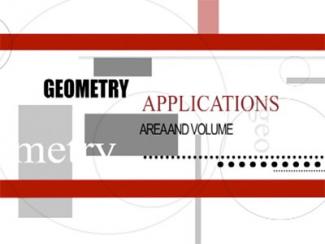
|
Closed Captioned Video: Geometry Applications: Area and Volume |
Closed Captioned Video: Geometry Applications: Area and VolumeTopicArea and Volume |
Applications of Surface Area and Volume, Surface Area and Volume |

|
Closed Captioned Video: Geometry Applications: Area and Volume |
Closed Captioned Video: Geometry Applications: Area and VolumeTopicArea and Volume |
Applications of Surface Area and Volume, Surface Area and Volume |

|
Closed Captioned Video: Geometry Applications: Area and Volume |
Closed Captioned Video: Geometry Applications: Area and VolumeTopicArea and Volume |
Applications of Surface Area and Volume, Surface Area and Volume |

|
Closed Captioned Video: Geometry Applications: Area and Volume |
Closed Captioned Video: Geometry Applications: Area and VolumeTopicArea and Volume |
Applications of Surface Area and Volume, Surface Area and Volume |

|
Closed Captioned Video: Geometry Applications: Area and Volume |
Closed Captioned Video: Geometry Applications: Area and VolumeTopicArea and Volume |
Applications of Surface Area and Volume, Surface Area and Volume |

|
Closed Captioned Video: Geometry Applications: Area and Volume |
Closed Captioned Video: Geometry Applications: Area and VolumeTopicArea and Volume |
Applications of Surface Area and Volume, Surface Area and Volume |
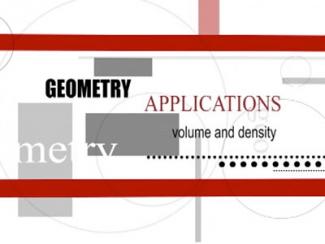
|
Closed Captioned Video: Geometry Applications: Area and Volume, 1 |
Closed Captioned Video: Geometry Applications: Area and Volume, 1TopicArea and Volume DescriptionThis segment explores the concept of density, using the Titanic to demonstrate buoyancy and the relationship between mass and volume. It introduces direct variation, rational functions, and how these principles apply to ship design for optimal floating capacity. |
Applications of Surface Area and Volume, Surface Area and Volume |

|
Closed Captioned Video: Geometry Applications: Area and Volume, 1 |
Closed Captioned Video: Geometry Applications: Area and Volume, 1TopicArea and Volume DescriptionThis segment explores the concept of density, using the Titanic to demonstrate buoyancy and the relationship between mass and volume. It introduces direct variation, rational functions, and how these principles apply to ship design for optimal floating capacity. |
Applications of Surface Area and Volume, Surface Area and Volume |

|
Closed Captioned Video: Geometry Applications: Area and Volume, 1 |
Closed Captioned Video: Geometry Applications: Area and Volume, 1TopicArea and Volume DescriptionThis segment explores the concept of density, using the Titanic to demonstrate buoyancy and the relationship between mass and volume. It introduces direct variation, rational functions, and how these principles apply to ship design for optimal floating capacity. |
Applications of Surface Area and Volume, Surface Area and Volume |

|
Closed Captioned Video: Geometry Applications: Area and Volume, 1 |
Closed Captioned Video: Geometry Applications: Area and Volume, 1TopicArea and Volume DescriptionThis segment explores the concept of density, using the Titanic to demonstrate buoyancy and the relationship between mass and volume. It introduces direct variation, rational functions, and how these principles apply to ship design for optimal floating capacity. |
Applications of Surface Area and Volume, Surface Area and Volume |

|
Closed Captioned Video: Geometry Applications: Area and Volume, 1 |
Closed Captioned Video: Geometry Applications: Area and Volume, 1TopicArea and Volume DescriptionThis segment explores the concept of density, using the Titanic to demonstrate buoyancy and the relationship between mass and volume. It introduces direct variation, rational functions, and how these principles apply to ship design for optimal floating capacity. |
Applications of Surface Area and Volume, Surface Area and Volume |

|
Closed Captioned Video: Geometry Applications: Area and Volume, 1 |
Closed Captioned Video: Geometry Applications: Area and Volume, 1TopicArea and Volume DescriptionThis segment explores the concept of density, using the Titanic to demonstrate buoyancy and the relationship between mass and volume. It introduces direct variation, rational functions, and how these principles apply to ship design for optimal floating capacity. |
Applications of Surface Area and Volume, Surface Area and Volume |

|
Closed Captioned Video: Geometry Applications: Area and Volume, 1 |
Closed Captioned Video: Geometry Applications: Area and Volume, 1TopicArea and Volume DescriptionThis segment explores the concept of density, using the Titanic to demonstrate buoyancy and the relationship between mass and volume. It introduces direct variation, rational functions, and how these principles apply to ship design for optimal floating capacity. |
Applications of Surface Area and Volume, Surface Area and Volume |

|
Closed Captioned Video: Geometry Applications: Area and Volume, 1 |
Closed Captioned Video: Geometry Applications: Area and Volume, 1TopicArea and Volume DescriptionThis segment explores the concept of density, using the Titanic to demonstrate buoyancy and the relationship between mass and volume. It introduces direct variation, rational functions, and how these principles apply to ship design for optimal floating capacity. |
Applications of Surface Area and Volume, Surface Area and Volume |

|
Closed Captioned Video: Geometry Applications: Area and Volume, 1 |
Closed Captioned Video: Geometry Applications: Area and Volume, 1TopicArea and Volume DescriptionThis segment explores the concept of density, using the Titanic to demonstrate buoyancy and the relationship between mass and volume. It introduces direct variation, rational functions, and how these principles apply to ship design for optimal floating capacity. |
Applications of Surface Area and Volume, Surface Area and Volume |

|
Closed Captioned Video: Geometry Applications: Area and Volume, 1 |
Closed Captioned Video: Geometry Applications: Area and Volume, 1TopicArea and Volume DescriptionThis segment explores the concept of density, using the Titanic to demonstrate buoyancy and the relationship between mass and volume. It introduces direct variation, rational functions, and how these principles apply to ship design for optimal floating capacity. |
Applications of Surface Area and Volume, Surface Area and Volume |

|
Closed Captioned Video: Geometry Applications: Area and Volume, 1 |
Closed Captioned Video: Geometry Applications: Area and Volume, 1TopicArea and Volume DescriptionThis segment explores the concept of density, using the Titanic to demonstrate buoyancy and the relationship between mass and volume. It introduces direct variation, rational functions, and how these principles apply to ship design for optimal floating capacity. |
Applications of Surface Area and Volume, Surface Area and Volume |
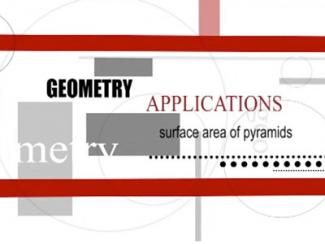
|
Closed Captioned Video: Geometry Applications: Area and Volume, 2 |
Closed Captioned Video: Geometry Applications: Area and Volume, 2TopicArea and Volume DescriptionThis segment focuses on surface area, using the Louvre Pyramid to highlight geometric tessellations and triangular net calculations. It explains the surface area formula for pyramids and how these calculations are applied in architectural design and material efficiency. |
Applications of Surface Area and Volume, Surface Area and Volume |

|
Closed Captioned Video: Geometry Applications: Area and Volume, 2 |
Closed Captioned Video: Geometry Applications: Area and Volume, 2TopicArea and Volume DescriptionThis segment focuses on surface area, using the Louvre Pyramid to highlight geometric tessellations and triangular net calculations. It explains the surface area formula for pyramids and how these calculations are applied in architectural design and material efficiency. |
Applications of Surface Area and Volume, Surface Area and Volume |

|
Closed Captioned Video: Geometry Applications: Area and Volume, 2 |
Closed Captioned Video: Geometry Applications: Area and Volume, 2TopicArea and Volume DescriptionThis segment focuses on surface area, using the Louvre Pyramid to highlight geometric tessellations and triangular net calculations. It explains the surface area formula for pyramids and how these calculations are applied in architectural design and material efficiency. |
Applications of Surface Area and Volume, Surface Area and Volume |

|
Closed Captioned Video: Geometry Applications: Area and Volume, 2 |
Closed Captioned Video: Geometry Applications: Area and Volume, 2TopicArea and Volume DescriptionThis segment focuses on surface area, using the Louvre Pyramid to highlight geometric tessellations and triangular net calculations. It explains the surface area formula for pyramids and how these calculations are applied in architectural design and material efficiency. |
Applications of Surface Area and Volume, Surface Area and Volume |

|
Closed Captioned Video: Geometry Applications: Area and Volume, 2 |
Closed Captioned Video: Geometry Applications: Area and Volume, 2TopicArea and Volume DescriptionThis segment focuses on surface area, using the Louvre Pyramid to highlight geometric tessellations and triangular net calculations. It explains the surface area formula for pyramids and how these calculations are applied in architectural design and material efficiency. |
Applications of Surface Area and Volume, Surface Area and Volume |

|
Closed Captioned Video: Geometry Applications: Area and Volume, 2 |
Closed Captioned Video: Geometry Applications: Area and Volume, 2TopicArea and Volume DescriptionThis segment focuses on surface area, using the Louvre Pyramid to highlight geometric tessellations and triangular net calculations. It explains the surface area formula for pyramids and how these calculations are applied in architectural design and material efficiency. |
Applications of Surface Area and Volume, Surface Area and Volume |

|
Closed Captioned Video: Geometry Applications: Area and Volume, 2 |
Closed Captioned Video: Geometry Applications: Area and Volume, 2TopicArea and Volume DescriptionThis segment focuses on surface area, using the Louvre Pyramid to highlight geometric tessellations and triangular net calculations. It explains the surface area formula for pyramids and how these calculations are applied in architectural design and material efficiency. |
Applications of Surface Area and Volume, Surface Area and Volume |

|
Closed Captioned Video: Geometry Applications: Area and Volume, 2 |
Closed Captioned Video: Geometry Applications: Area and Volume, 2TopicArea and Volume DescriptionThis segment focuses on surface area, using the Louvre Pyramid to highlight geometric tessellations and triangular net calculations. It explains the surface area formula for pyramids and how these calculations are applied in architectural design and material efficiency. |
Applications of Surface Area and Volume, Surface Area and Volume |

|
Closed Captioned Video: Geometry Applications: Area and Volume, 2 |
Closed Captioned Video: Geometry Applications: Area and Volume, 2TopicArea and Volume DescriptionThis segment focuses on surface area, using the Louvre Pyramid to highlight geometric tessellations and triangular net calculations. It explains the surface area formula for pyramids and how these calculations are applied in architectural design and material efficiency. |
Applications of Surface Area and Volume, Surface Area and Volume |

|
Closed Captioned Video: Geometry Applications: Area and Volume, 2 |
Closed Captioned Video: Geometry Applications: Area and Volume, 2TopicArea and Volume DescriptionThis segment focuses on surface area, using the Louvre Pyramid to highlight geometric tessellations and triangular net calculations. It explains the surface area formula for pyramids and how these calculations are applied in architectural design and material efficiency. |
Applications of Surface Area and Volume, Surface Area and Volume |

|
Closed Captioned Video: Geometry Applications: Area and Volume, 2 |
Closed Captioned Video: Geometry Applications: Area and Volume, 2TopicArea and Volume DescriptionThis segment focuses on surface area, using the Louvre Pyramid to highlight geometric tessellations and triangular net calculations. It explains the surface area formula for pyramids and how these calculations are applied in architectural design and material efficiency. |
Applications of Surface Area and Volume, Surface Area and Volume |
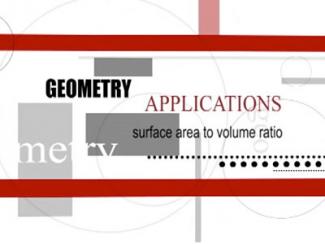
|
Closed Captioned Video: Geometry Applications: Area and Volume, 3 |
Closed Captioned Video: Geometry Applications: Area and Volume, 3TopicArea and Volume DescriptionThis segment explores the surface area-to-volume ratio using the Citigroup Building as an example. It discusses how this ratio impacts energy efficiency in buildings and compares it to natural examples like polar bears and snakes for context. |
Applications of Surface Area and Volume, Surface Area and Volume |

|
Closed Captioned Video: Geometry Applications: Area and Volume, 3 |
Closed Captioned Video: Geometry Applications: Area and Volume, 3TopicArea and Volume DescriptionThis segment explores the surface area-to-volume ratio using the Citigroup Building as an example. It discusses how this ratio impacts energy efficiency in buildings and compares it to natural examples like polar bears and snakes for context. |
Applications of Surface Area and Volume, Surface Area and Volume |

|
Closed Captioned Video: Geometry Applications: Area and Volume, 3 |
Closed Captioned Video: Geometry Applications: Area and Volume, 3TopicArea and Volume DescriptionThis segment explores the surface area-to-volume ratio using the Citigroup Building as an example. It discusses how this ratio impacts energy efficiency in buildings and compares it to natural examples like polar bears and snakes for context. |
Applications of Surface Area and Volume, Surface Area and Volume |

|
Closed Captioned Video: Geometry Applications: Area and Volume, 3 |
Closed Captioned Video: Geometry Applications: Area and Volume, 3TopicArea and Volume DescriptionThis segment explores the surface area-to-volume ratio using the Citigroup Building as an example. It discusses how this ratio impacts energy efficiency in buildings and compares it to natural examples like polar bears and snakes for context. |
Applications of Surface Area and Volume, Surface Area and Volume |

|
Closed Captioned Video: Geometry Applications: Area and Volume, 3 |
Closed Captioned Video: Geometry Applications: Area and Volume, 3TopicArea and Volume DescriptionThis segment explores the surface area-to-volume ratio using the Citigroup Building as an example. It discusses how this ratio impacts energy efficiency in buildings and compares it to natural examples like polar bears and snakes for context. |
Applications of Surface Area and Volume, Surface Area and Volume |

|
Closed Captioned Video: Geometry Applications: Area and Volume, 3 |
Closed Captioned Video: Geometry Applications: Area and Volume, 3TopicArea and Volume DescriptionThis segment explores the surface area-to-volume ratio using the Citigroup Building as an example. It discusses how this ratio impacts energy efficiency in buildings and compares it to natural examples like polar bears and snakes for context. |
Applications of Surface Area and Volume, Surface Area and Volume |

|
Closed Captioned Video: Geometry Applications: Area and Volume, 3 |
Closed Captioned Video: Geometry Applications: Area and Volume, 3TopicArea and Volume DescriptionThis segment explores the surface area-to-volume ratio using the Citigroup Building as an example. It discusses how this ratio impacts energy efficiency in buildings and compares it to natural examples like polar bears and snakes for context. |
Applications of Surface Area and Volume, Surface Area and Volume |

|
Closed Captioned Video: Geometry Applications: Area and Volume, 3 |
Closed Captioned Video: Geometry Applications: Area and Volume, 3TopicArea and Volume DescriptionThis segment explores the surface area-to-volume ratio using the Citigroup Building as an example. It discusses how this ratio impacts energy efficiency in buildings and compares it to natural examples like polar bears and snakes for context. |
Applications of Surface Area and Volume, Surface Area and Volume |

|
Closed Captioned Video: Geometry Applications: Area and Volume, 3 |
Closed Captioned Video: Geometry Applications: Area and Volume, 3TopicArea and Volume DescriptionThis segment explores the surface area-to-volume ratio using the Citigroup Building as an example. It discusses how this ratio impacts energy efficiency in buildings and compares it to natural examples like polar bears and snakes for context. |
Applications of Surface Area and Volume, Surface Area and Volume |

|
Google Earth Voyager Story: The Geometry of Sustainable Architecture, Part 1 |
Google Earth Voyager Story: The Geometry of Sustainable Architecture, Part 1TopicGeometric Models |
Applications of Surface Area and Volume and Rational Functions and Equations |

|
Google Earth Voyager Story: The Geometry of Sustainable Architecture, Part 1 |
Google Earth Voyager Story: The Geometry of Sustainable Architecture, Part 1TopicGeometric Models |
Applications of Surface Area and Volume and Rational Functions and Equations |
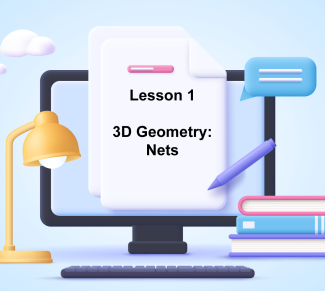
|
Lesson Plan: Nets of 3D Figures, Part 1 |
Lesson Plan: Introduction to Nets and Basic 3D Shapes In this engaging and interactive lesson, students explore the connection between 2D nets and 3D geometric figures. Through animations, printable foldable nets, and hands-on activities, students will develop a deeper understanding of how nets transform into solid figures such as cubes, rectangular prisms, and triangular prisms. This lesson also reinforces key geometry concepts, including faces, edges, and vertices, while guiding students through surface area calculations using nets. |
3-Dimensional Figures |
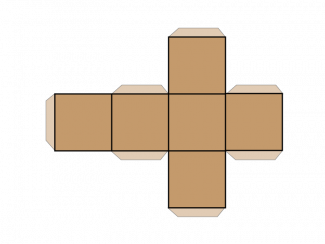
|
Math Clip Art--Net for a Cube |
Math Clip Art--Net for a CubeTopicGeometry DescriptionThis math clip art image is part of a series showcasing 2D nets of 3D figures, specifically focusing on the net for a cube. The image displays a flattened representation of a cube, consisting of six connected squares arranged in a cross-like pattern. This visual aid is crucial for students to understand the relationship between 2D shapes and their 3D counterparts. |
3-Dimensional Figures |

|
Math Clip Art--Net for a Pyramid |
Math Clip Art--Net for a PyramidTopicGeometry DescriptionThis math clip art image is part of a series illustrating 2D nets of 3D figures, with this particular image focusing on the net for a pyramid. The image shows a flattened representation of a square-based pyramid, consisting of a square base surrounded by four triangular faces. This visual aid is essential for students to comprehend how a 3D pyramid can be unfolded into a 2D pattern. |
3-Dimensional Figures |
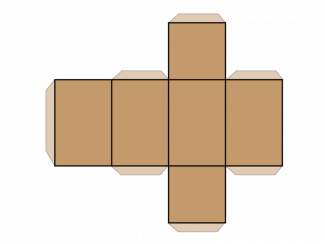
|
Math Clip Art--Net for a Rectangular Prism |
Math Clip Art--Net for a Rectangular PrismTopicGeometry DescriptionThis math clip art image is part of a series showcasing 2D nets of 3D figures, specifically illustrating the net for a rectangular prism. The image displays a flattened representation of a rectangular prism, consisting of six connected rectangles arranged in a cross-like pattern. This visual aid is crucial for students to understand how a 3D rectangular prism can be unfolded into a 2D shape. |
3-Dimensional Figures |

|
Math Clip Art--Net for a Triangular Prism |
Math Clip Art--Net for a Triangular PrismTopicGeometry DescriptionThis math clip art image is part of a series illustrating 2D nets of 3D figures, with this particular image focusing on the net for a triangular prism. The image shows a flattened representation of a triangular prism, consisting of two triangular bases and three rectangular faces. This visual aid is essential for students to comprehend how a 3D triangular prism can be unfolded into a 2D pattern. |
3-Dimensional Figures |
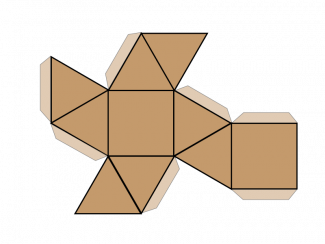
|
Math Clip Art--Net for an Antiprism |
Math Clip Art--Net for an AntiprismTopicGeometry DescriptionThis math clip art image is part of a series showcasing 2D nets of 3D figures, specifically illustrating the net for an antiprism. The image displays a flattened representation of an antiprism, consisting of two polygonal bases (typically regular polygons) connected by a band of triangles. This visual aid is crucial for students to understand how a 3D antiprism can be unfolded into a 2D shape. |
3-Dimensional Figures |

|
Video Transcript: Geometry Applications: Area and Volume |
Video Transcript: Geometry Applications: Area and Volume
This is the transcript for the video of same title. Video contents: In this program we look at applications of area and volume. We do this in the context of three real-world applications. In the first, we look at the sinking of the Titanic in the context of volume and density. In the second application we look at the glass pyramid at the Louvre Museum and calculate its surface area. In the third application we look at the Citibank Tower in New York City to study the ratio of surface area to volume to learn about heat loss in tall buildings. |
Applications of Surface Area and Volume |

|
Video Transcript: Geometry Applications: Area and Volume |
Video Transcript: Geometry Applications: Area and Volume
This is the transcript for the video of same title. Video contents: In this program we look at applications of area and volume. We do this in the context of three real-world applications. In the first, we look at the sinking of the Titanic in the context of volume and density. In the second application we look at the glass pyramid at the Louvre Museum and calculate its surface area. In the third application we look at the Citibank Tower in New York City to study the ratio of surface area to volume to learn about heat loss in tall buildings. |
Applications of Surface Area and Volume |

|
Video Transcript: Geometry Applications: Area and Volume |
Video Transcript: Geometry Applications: Area and Volume
This is the transcript for the video of same title. Video contents: In this program we look at applications of area and volume. We do this in the context of three real-world applications. In the first, we look at the sinking of the Titanic in the context of volume and density. In the second application we look at the glass pyramid at the Louvre Museum and calculate its surface area. In the third application we look at the Citibank Tower in New York City to study the ratio of surface area to volume to learn about heat loss in tall buildings. |
Applications of Surface Area and Volume |

|
Video Transcript: Geometry Applications: Area and Volume |
Video Transcript: Geometry Applications: Area and Volume
This is the transcript for the video of same title. Video contents: In this program we look at applications of area and volume. We do this in the context of three real-world applications. In the first, we look at the sinking of the Titanic in the context of volume and density. In the second application we look at the glass pyramid at the Louvre Museum and calculate its surface area. In the third application we look at the Citibank Tower in New York City to study the ratio of surface area to volume to learn about heat loss in tall buildings. |
Applications of Surface Area and Volume |